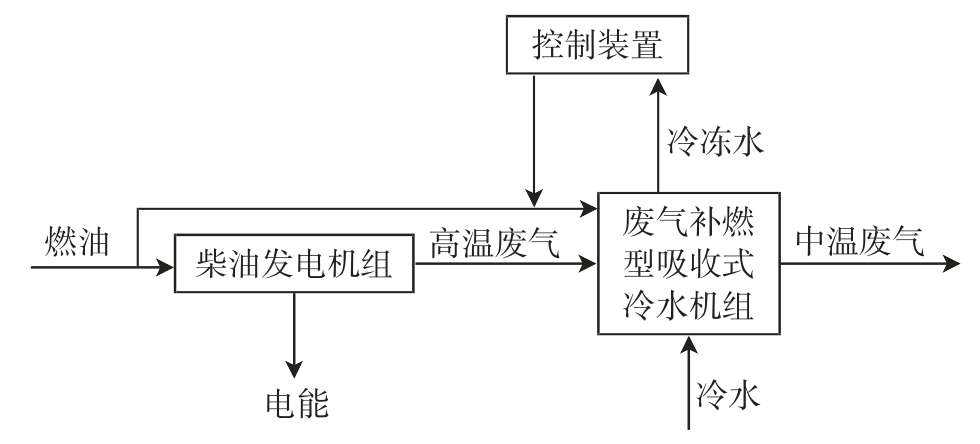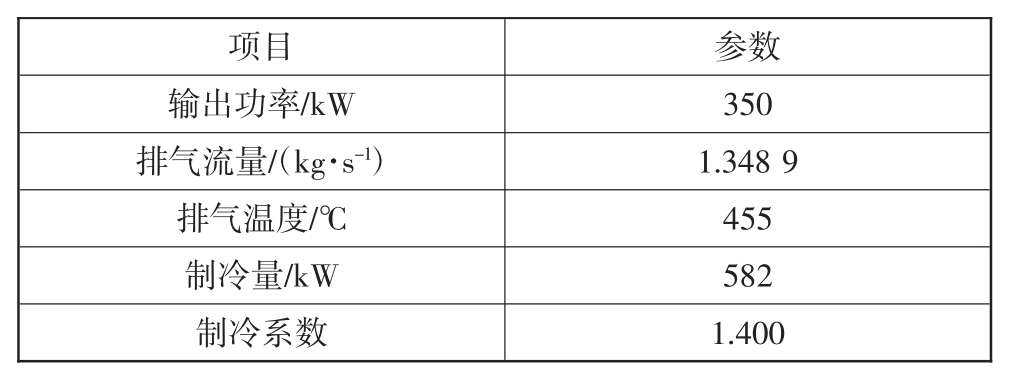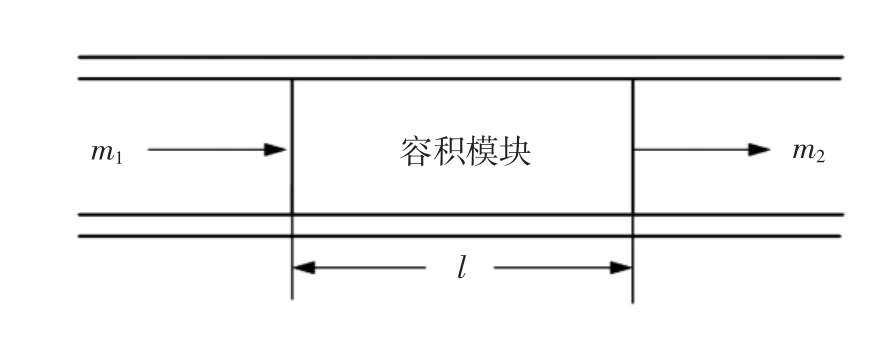Hotline 0086-519-86239986
All News
Design And Performance Analysis Of A 16kw Diesel Generator Refrigeration System Using Waste Heat
From the past research situation, the design and simulation of distributed cogeneration system is too mode.
1 system integration design
The selected island residential area is powered by 16kw diesel generator, the exhaust gas of diesel engine contains a lot of heat energy, and the Lithium Bromide absorption chiller takes the exhaust gas as the working heat source to refrigerate for users. In order to increase the adjustable range of cooling load, the afterburning type refrigerator is adopted. The overall design of the island's 16kw diesel generator system is illustrated in figure 1.
Based on the design principle of electric cooling (matching chiller according to 16kw diesel generator) , the matching selection of chiller is carried out in this paper. The residential area has a gross floor area of about 4,850 M2 and a 16 kw diesel generator rated power of 350 kw. The 16 kW diesel generator produces exhaust gas at a temperature of about 450°C, and the heat energy available to the chiller is about 420 kW. The double-effect parallel lithium bromide absorption chiller with refrigeration Coefficient of 1.4 and power of 582kW was selected. The average cooling load of island users is 120W/m2. According to the investigation, 120W/m2 meets the demand of island users for cooling load. Therefore, when the 16kw diesel generator is operated under the rated working condition, the waste heat from the exhaust gas can meet the demand of the refrigerator. The design parameters of the 16kw diesel generator refrigeration system are shown in Table 1.
2. Mathematical modeling
The 16kw diesel generator refrigeration system is very complex, which involves many subjects such as dynamics, thermodynamics and heat transfer, so it is very important to choose a suitable modeling method. In this paper, the simulation model of the 16kw waste heat utilization refrigeration system is established by using the modular modeling method. The 16kw diesel generator waste heat utilization refrigeration system is a typical thermodynamic system, the modules are divided according to the passage of working substance and energy.
After determining the whole modeling idea, we should choose a reasonable method to simulate the operation of the system accurately.
This paper mainly studies the output power and exhaust heat energy of 16kw diesel generator under different loads, without considering the internal working process of 16kw diesel generator. Modeling using the averaging method ensures the accuracy of the 16kw diesel generator simulation at the system integration level.
There are many types of heat exchangers in the 16kw diesel generator refrigeration system, and there is pressure-flow coupling between the heat exchangers. The traditional modeling method divides the module according to the physical model, calculates the pressure and flow of each module separately according to the balance equation, and must satisfy the boundary equal restriction condition. Therefore, the iterative computation is unavoidable and the computation time is increased. In order to solve this problem, a simulation model of a 16kw diesel generator refrigeration system using waste heat is established by the volumetric inertia method.
According to the volumetric inertia method, the flow rate in each component is not balanced, and each component is considered according to the volumetric inertia link. It regards each component as a volume module, and the connecting pipe between each component as a resistance module. For the volume module, ignoring the internal fluid resistance, the pressure inside the volume module is uniform. The pressure in the volume module can be calculated according to the difference of mass flow rate at both ends of the volume module and the temperature change in the volume module. However, the pressure difference between the inlet and outlet and the friction loss of the pipe wall make the flux change, and the dynamic value of flux can be calculated according to the conservation of momentum.
Taking a length of l pipe as an example, it is divided into volume module and resistance module, and its volume inertia model is established.
1) volume module.
The flow rate per unit time into the volume module is M1, and the flow rate per unit time out of the volume module is M2. According to the conservation of Mass: Flow into the volume module-flow out of the volume module = volume module mass increment, the volume module mass increment can be calculated:

In the formula: M is the mass of the working fluid in the volume module, kg; v is the volume of the working fluid in the volume module, M3; kg/m3 is the density of the working fluid in the volume module; M1 and M2 are the mass flow of the fluid in and out of the volume module, kg/s.
2) resistive module.
In the resistive module, the flow rate changes due to the pressure difference and the frictional resistance of the fluid. According to the law of conservation of LINEAR MOMENTUM: The momentum entering the resistive module-the momentum leaving the resistive module + the momentum of the external force = the resistive module momentum increment, the mass of the fluid flowing through the resistive module cross section can be calculated:
pagenumber_ebook=33,pagenumber_book=25
In the formula: M is the mass flow rate of the working fluid through the pipe, kg/s; v is the velocity of the working fluid, m/s; a is the cross-sectional area of the pipe, m 2; l is the length of the pipe, m; p 1 and P 2 are the pressures on both sides of the resistive module, PA; U L is the frictional resistance of the fluid on the wall of the pipe, the minus sign represents the frictional resistance in the opposite direction to the flow of the fluid, U is the wet circumference of the pipe, U is the frictional resistance per unit area, = 1/2 F V 2, F is the friction coefficient of the heat exchanger along the way, which can be obtained according to the empirical formula.
3 system performance analysis
In this paper, a four stroke turbocharged 16kw diesel generator is divided into compressor, turbine, turbine rotor, intercooler, intake and exhaust pipe, governor, cylinder and generator, a 16kw diesel generator simulation model was built using the average method.
The 16kw diesel generator refrigeration system has a large number of heat exchangers, and the volumetric inertia method is used to build the simulation models of each component. The liquid working medium in the system mainly consists of waste gas, lithium Bromide Solution, water, water vapor and so on. In order to guarantee the accuracy of the model calculation, a model for calculating the thermal properties of working medium was established according to the fitting formula. The simulation models of 16kw and lithium bromide absorption chillers are built and debugged respectively in Matlab/Simulink software. Finally, the simulation model of 16kw diesel generator chillers using waste heat is combined as shown in figure 4.
In the steady-state simulation, according to the design parameters, firstly, the boundary conditions are set in Matlab/Simulink simulation software, and the initial values of the state variables of the model are assigned. The ODE45 Algorithm with high simulation accuracy is used to set the simulation time as 2000s. Table 2 shows the comparison between steady-state simulation results and design parameters.

Table 2 shows that the relative error between the steady-state simulation value and the design parameters of the 16kw diesel generator refrigeration system is less than 3% , which meets the system simulation precision requirement and verifies the correctness and accuracy of the simulation model. The thermal parameters of working medium in the system are obtained by fitting formula, the necessary assumptions are made in modeling, and the errors of the components will be magnified when they are assembled, these are the reasons for the relative errors.
Based on the steady state simulation results, the total energy utilization Coefficient of the 16kw diesel generator waste heat utilization refrigeration system was evaluated. The calculation method of the Total Energy Utilization Coefficient of the system is as a formula.
X is the total Energy Utilization Coefficient of the 16kw diesel generator system, PG is the 16kw diesel generator, kW, RC is the libr absorption chiller, kW, EC is the other energy consumption of the system, kW; The FC is diesel generator fuel consumption, kW; the PC is system power consumption, kW.
Under the designed operating conditions, the 16kw diesel generator has a capacity of 357.6 kW, the Lithium Bromide Absorption Chiller has a capacity of 579.79 kW, the other energy consumption of the system is 132 kW, and the fuel consumption of the 16kw diesel generator is about 1286 kW, the power consumption of pumps and other power-consuming equipments in the system is about 30kw.
According to the calculation of Formula (6) , the Total Energy Utilization Coefficient of the 16kw diesel generator refrigeration system is about 0.813, and the energy utilization efficiency is greatly improved, which is more than 0.8, and meets the design requirements.

The load of the 16kw diesel generator is determined by the power consumption. The change of the load will result in the change of the exhaust temperature and flow rate of the 16kw diesel generator, which will affect the cooling capacity of the Lithium Bromide absorption chiller downstream of the system.
The thermodynamic process of the system is complex, with inertial delays. Setting the whole simulation time to 6000s, starting from the 2000s, adding the step change, the load of 16kw diesel generator is reduced from 100% to 80% , and the dynamic simulation calculation is carried out.
Starting from the 2000s, the load is reduced from 352.3 kW to 287.48 kW, the exhaust flow from 1.3187 kgs to 1.1192 kgs, and the exhaust temperature from 462°C to 453 °C for the 16kw diesel generator. The whole dynamic response process is about 100s. Diesel load reduced by 20% , diesel engine speed increased, governor rapid response, reduce fuel injection to maintain speed stability at set point. The decrease of fuel injection in diesel engine results in the decrease of exhaust temperature and flow rate.
The cooling capacity increased slightly and then dropped rapidly to another stable value, from 579.79 kW to 507.15 kW. As can be seen from figure 9, the coefficient of refrigeration increased slightly and then decreased from 1.394 to 1.402. The decrease of the 16kw diesel generator load resulted in the decrease of the heat energy entering the whole 16kw diesel generator system, which led to the decrease of the refrigerating capacity of the chiller, but the refrigerating coefficient increased slightly, and the whole dynamic process was completed about 2000s.
4 CONCLUSION
Taking a residential area of an island as an example, a new energy-saving refrigeration technology using waste heat from diesel power generation is studied.
1) the integrated design of a 16kw diesel generator waste heat utilization refrigeration system was carried out, and the design parameters were determined. Through the system static and dynamic simulation calculation, the system performance is analyzed, then the control system is designed and the optimization of the system is realized.
2) the steady-state simulation is carried out in the design condition, and the relative error is less than 3% , which meets the design requirement and validates the accuracy and correctness of the model. According to the results of steady-state simulation, the total energy utilization Coefficient of the system is about 0.813, which meets the design requirements.
3) the dynamic simulation of 16kw load disturbance is carried out, which results in the reduction of the 16kw load, the reduction of the power generation, the reduction of the heat energy of the exhaust gas, the reduction of the cooling capacity and the slight increase of the cooling coefficient. The simulation results show that the cooling capacity of the 16kw power station is lower than that of the 16kw power station, and the output of the 16kw power station is lower than that of the 16kw power station, and the heat energy of the exhaust gas is lower than that of the 16kw diesel generator.

